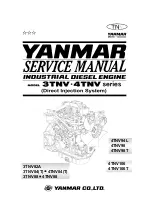
Welding work
Never carry out welding work on the assembly, system, or engine-mounted units. Cover the engine when
welding in its vicinity.
Do not use the assembly or system as ground terminal.
Do not route the welding lead over or near the wiring harnesses of MTU systems. The welding current
may otherwise induce an interference voltage in the wiring harnesses which could conceivably damage
the electrical system.
Remove parts (e.g. exhaust pipes) which are to be welded from the engine beforehand.
Hydraulic installation and removal
Check the function and safe operating condition of tools and fixtures to be used. Use only the specified
devices for hydraulic removal/installation procedures.
Observe the max. permissible push-on pressure specified for the equipment.
Do not attempt to bend or apply force to lines.
Before starting work, pay attention to the following:
• Vent the hydraulic installation/removal tool, the pumps and the lines at the relevant points for the
equipment to be used (e.g. open vent plugs, pump until bubble-free air emerges, close vent plugs).
• For hydraulic installation, screw on the tool with the piston retracted.
• For hydraulic removal, screw on the tool with the piston extended.
For a hydraulic installation/removal tool with central expansion pressure supply, screw spindle into shaft
end until correct sealing is established.
During hydraulic installation and removal, ensure that nobody is standing in the immediate vicinity of the
component to be installed/removed.
Working on electrical/electronic assemblies
Always obtain the permission of the person in charge before commencing maintenance and repair work
or switching off any part of the electronic system required to do so.
De-energize the appropriate areas prior to working on assemblies.
Do not damage cabling during removal work. When reinstalling ensure that wiring is not damaged during
operation by contact with sharp objects, by rubbing against other components or by a hot surface.
Do not secure cables on lines carrying fluids.
Do not use cable binders to secure cables.
Always use connector pliers to tighten connectors.
Subject the device or system to a function check on completion of all repair work.
Store spare parts properly prior to replacement, i.e. protect them against moisture in particular. Pack de‐
fective electronic components and assemblies in a suitable manner when dispatched for repair, i.e. par‐
ticularly protected against moisture and impact and wrapped in antistatic foil if necessary.
Working with laser equipment
When working with laser equipment, always wear special laser-protection goggles ⇒ Heavily focused ra‐
diation.
Laser equipment must be fitted with the protective devices necessary for safe operation according to
type and application.
MS150095/01E 2012-08 | Safety | 9
TIM-ID: 0000000879 - 023










































